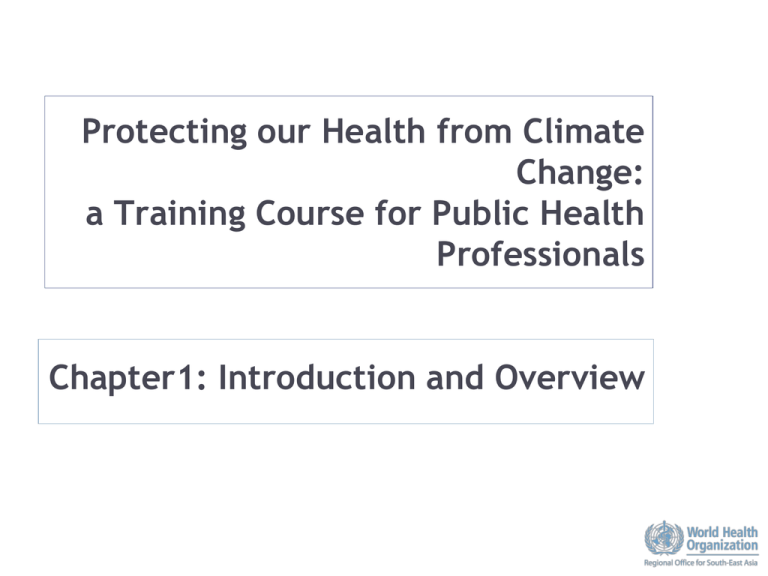Protecting our Health from Climate Change: a Training Course for Public Health Professionals
advertisement

Protecting our Health from Climate Change: a Training Course for Public Health Professionals Chapter1: Introduction and Overview Overview This module provides an introduction to global environmental change and the issues that will be covered in the course “Protecting our Health from Climate Change” Historical Perspective Over past 10,000 years, humans have altered their environment – Leading to increased population size, improved living conditions, and increased life expectancy Last 150+ years, gains in population health from increasing: – – – – Access to safe water and sanitation Food security Access to simple medical care Education and literacy Epidemiology Since ~1850: Changes in Emphasis / Units of Analysis Population – Germ theory – Micronutrients 1850 s Sub-groups – Occupational risks Individuals – Non-infectious diseases – Individual risk factors – Genetics and epigenetics 1900 s 1950 s 21st Century The risks populations are facing have become more complex, larger scale, and potentially more devastating Global environmental changes mean that environmental epidemiology must now study current and future health risks due to changes in climate, food systems, water resources, and other factors Main Global Environmental Changes Atmospheric composition and chemistry Food systems Freshwater resources Biodiversity Changes to global cycles of major elements Persistent organic pollutants Pathways from Global Change to Human Health Global change Demographic change Aging family structures urbanization Social change Institutions governance Environmental degradation, ecosystem disturbances, geophysical changes Human health Economic activities Trade wealth creation and distribution Ecosystem Services and Human Health Regeneration of fertile land food Viable fisheries food Wetlands: flood storage, cleansing of surface water Nutrient recycling (nitrogen, phosphorus, etc.) Intact ecosystems: control of infectious disease vectors (mosquitoes, ticks, rodents) Buffering against environmental stressors (protection by forests and reefs against cyclones, storm surges, and droughts) Source of medicinals Support/inspiration for aesthetic/spiritual values What is Different About Studying the Health Impacts of Global Change? Temporal and spatial scale issues Not a discrete exposure Everyone is exposed Exposures will increase over coming decades – Risks will increase with increasing exposures Impacts operate through a wide range of pathways Scale and Type of Environmental Health Risks Global change Regional air pollution Acid rain, Asian brown cloud Extremes of exposures; disruption of life/health-support systems Local air pollution Environmental tobacco smoke Direct, toxic, hazard Not Just Environment Changing Worldwide emergence and re-emergence of infectious diseases since 1970s Increase in obesity and diabetes Trade and travel increasing transport of lifestyles, infectious people, hazardous materials, …. Export of occupational hazards to low-income countries Increasing income inequalities World Population: 1960 and 2050 1960 2050 Worldmapper, 2008b, e National Carbon Dioxide Emissions World Wildlife Fund Living Planet Report 2006 World Wildlife Fund, 2006 Millennium Ecosystem Assessment (2005): Ecosystems and Human Wellbeing Water Poverty Index The Centre for Ecology & Hydrology of the United Kingdom, 2005 Projected Changes in Length of Growing Season, 2050 ECHam4, B1 > 20% loss 5-20% loss No change 5-20% gain >20% gain International Livestock Research Institute, 2006 ECHam4, B2 Cereal Production under GCM Scenarios Local air pollution Environmental tobacco smoke Food Web and Future Productivity of Ocean Fisheries Affected by Increasing ocean temperatures Ocean acidification – Zooplankton, crustaceans, shellfish sensitive to pH Over-fishing 25% of commercially exploited marine fish stocks are now seriously over-harvested (Millennium Ecosystem Assessment, 2005) Human Changes to Global Activated Nitrogen Cycle, 1900-2050 Human health risks include: – Decreased crop yields – Nitrogen oxides (air pollution) Asian Brown Cloud United Nations Environment Program (UNEP) estimates 1-2 million deaths in India annually from atmospheric pollution Asia’s brown haze is also altering regional weather, creating acid rain, and (perhaps) affecting forest and crop yields Lyme Disease: Influence of Habitat Fragmentation and Biodiversity Loss High Lyme Disease risk (humans) Woodland suburban housing (NE USA) Complex lifecycle of tick High tick density and high tick infection prevalence infected deer Proliferation of mice Loss of diversity of vertebrate predators and microbial host species Forest fragmentation, hunting (wolves, passenger pigeons) Increase in “competent” reservoir species – readily infected Reduced regulation between species Whose Research Task? Epidemiology is the study of the distribution and determinants of diseases in populations, and of ways to reduce the burden of disease Some say that global environmental change is too big/too complex for epidemiologists to study – Then who will ensure that population health is protected from expected impacts? – Epidemiology has a responsibility to address societal needs


